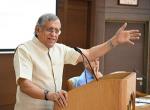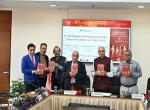On 17th August, 2021, Vivekananda International Foundation organized a book discussion on ‘Indus Basin Uninterrupted- A History and Politics from Alexander to Nehru’ By Dr Uttam Kumar Sinha. The opening remarks were given by Dr Arvind Gupta, Director VIF, in which he described the book as a ‘truly fascinating story of the Indus water river basin’. He also applauded the author for going back into the history and starting from the time of Alexander bringing the readers to the time of 1960 when India and Pakistan signed a treaty called the Indus Water Treaty. Additionally, Dr Gupta, in his opening remarks, gave his brief point of view about the book, which consisted of several important points. Firstly, how the river, the basin, and Indian history are interlinked with each other and how they have influenced each other has come out very beautifully in the book according to Dr Gupta. Next, he mentioned about the author’s style of writing which was interpreted as a very engaging and an easy style of writing. Another important aspect highlighted by Dr Gupta was the methodology of the book. He mentioned that the book was an extremely well researched book with both primary and secondary sources weaved in altogether in a masterly account of the Indus water Basin. Another important point which was highlighted was that the book raises many questions, particularly when the author talks about the growth of irrigation infrastructure in the Indus water. According to Dr Gupta, the book is the most comprehensive one ever written on the subject and the one that can be read even by a non-expert because of the style of writing the author has taken.
In the course of next one hour many important aspects of the book were discussed by the author. He started with a brief introduction of the book. According to him, the book covers a long history of the Indus Basin spanning the millennia from the Harappan Mohenjo-Daro Civilization to sixty years ago when Indus Water Treaty was signed. Divulging further, he explains that the book has been divided into five parts which covers themes concerning society’s relationship with the Indus Basin ranging from conquest, commerce and territorial demarcation to development and administration of the water. Dr Sinha then goes on to explain what the five parts of the book comprises of. Part one, according to him, begins with the arrival of Alexander of Macedonia which then proceeds to various invasions and successions from Abbasid Caliphate to the Mughals then to the British. In part two and three of the book, the author attempts to contextualize strategic importance of Punjab and the frontier territories or the trans-Indus region amidst Britain’s rivalry with Russia during the Great Game. This particular section also comprises of a crucial intersection of knowledge and power. For part four, Dr Sinha, focuses on the Indian engineers who applied the topographical expertise to secure the benefits for Independent India. The last part of the book deals with an account of the long years of negotiations on Indus water till the treaty was signed in 1960.
The author goes on to describe the book as a tale of personal motivations. These include pride, power, envy, fear, desperation, and greed. Dr Sinha in this book has tried to demonstrate this through carefully curated quotes from the archival research that he has done which includes ancient texts, travel diaries, writings of the foreigners who travelled during the 9th-10th centuries, letters written by people spanning the ages, and field notes of engineers. This leads to looking at the basin in a remarkable way which is also of great importance even today as it holds great significance in terms of agriculture and food production. He also pointed out that while writing the book there were many times when he was struck by the kind of actions that have happened in the past in the basin and elaborates that the knowledge one gets through these actions is of quite great importance.
The structure of the book, according to the author, was shaped by the archives and the information gathered by him. He also emphasized that in a certain sense the book gives a picture of humanities’ intimate connection to the Indus and how its tributaries in a way humanizes the Indus rather than treats it as a hydraulic object. The book also captures different characters that have gone into the making of Indus Basin, for example, the decisions that people took and many more.
Explaining the idea behind the subtitle of the book, Dr Sinha mentions that the Indus Basin not only has a deep and rich hydrology heritage but it also has a history of territory and politics and therefore the subtitles point out to the intermingling and intersection of the territory and politics. Out of the many striking features that the author speaks about, one is the significance of history even in today’s time and scenario. He gives example of the fact that even with new sets of technology, new data, and new investments on our water resources we still try to look back through the ages for better water management. Another example that he gives is the demise of Indus Civilization because of climate change which he thinks is very instructive in today’s time.
The author further delves into various themes of the book. Starting with how water development became linked to prosperity and the legitimacy of the ruler. A great example that was given by him was the reign of Avantivarman in Kashmir and how things dramatically changed by the utilization of the Vitasta river (now Jhelum). In fact, according to the author, many developments that took place on the Jhelum during that time are a forerunner to the present-day multipurpose river valley projects in Kashmir. He also talks about how the subject of ‘water’ featured in the mental framework of leaders in India as it did in the past ranging from Feroze Shah to Akbar, Bajpayee to Manmohan Singh, and Narendra Modi. Hence, according to Dr Sinha, the past and the present have striking similarities.
He then goes onto explain the theme of ‘knowledge and power’. Under this theme, the author emphasizes on the knowledge which was coming in through the formal engineers and also with the localized skills. He argues that this interconnection of formal engineering and localized skill facilitated the British to expand the irrigation system in the latter half of the 19th century. Additionally, the book has also captured the tension between the civil administration and the engineer’s mindset that later formed an alignment as the irrigation system developed. During that time, there was also an engineering class emerging which was soon to become administrators. According to the author, the late 19th century is a remarkable period of knowledge and power coming together and how the entire network of irrigation expanded in the Basin. Additionally, emerging disputes and formalized channels of addressing have also been captured through various documents and certain correspondence finds a lot of space in the book.
Dr Sinha then proceeds towards part four and part five of the book which he describes as more contemporary and which also consists of some striking revelations. First, he talks about the nationalist argument of the Indian civil engineers post partition which was clearly about India’s right as an upper riparian state. Second revelation which he talks about is that as the negotiations unfolded from 1952 onwards between India and Pakistan, there seemed to be a certain engineering unison which emerged with the intention to see the region as a homogenous physiographic region and to develop and utilize the water resources in the basin. Third was that a strong sub-nationalism was emerging between East Punjab and the center. For East Punjab, their leaders and their engineers did not align with the re-conciliatory outlook of Nehru which has been captured in the book. Another revelation made by the author is the great influence of the Tennessee Valley Authority (TVA). The book has captured the extensive debates which took place around March 1947 in the constituent assembly about TVA’s vision and its great water development project. Additionally, Dr Sinha also mentioned about Ambedkar who was one of the early persons to be influenced by the TVA and who understood the great advantage of having an engineer from the TVA come to India for the development of river basins and he succeeded in this vision of his.
The writer continues by highlighting the critical role of World Bank in the culmination of the Indus Water Treaty. He brings out letter exchanges between David Lilienthal and Eugene Black who were not in the favour of Kashmir becoming the next Korea and wanted to develop the basin. The World Bank had the resources and the financial ability to do so and Lilienthal had the vision of the TVA. So, this section of the book captures the alignment of the TVA and World Bank along with a larger political objective and U.S.’s administration outlook.
For the final part of the book, Dr Sinha focuses on this wonderful political debate that emerges in November of 1960 in Lok Sabha on the Indus River Basin. Despite various criticisms and scrutiny, a political consensus did emerge and the treaty was signed and ratified. This section also gives a picture of Nehru’s mindset, his way of looking at Pakistan, and his larger worldview. Describing the situation now, Dr Sinha claimed that things had dramatically changed since 1960 and that the Treaty continues but the future seemed uncertain. He also focuses on the way forward and suggests that India should focus on optimizing the Treaty and also to pay considerable attention to the development of western rivers in Kashmir. Closing his remarks, the author spoke on how the emphasis on Kashmir was now on the water development process and according to him this was a big shift in the way we understand the Treaty now.
Additional remarks were then made by Dr Arvind Gupta in which he highlighted the fact that in the course of the talk, the speaker brought out many points which were relevant in understanding the importance of Indus Water Treaty and that there also lessons to learn from it. He also adds a couple of points which from his perspective holds great importance even today. Dr Gupta spoke about the fact that even though there are global frameworks the upper-lower riparian angst will never go away. Next, he talked about the issue of sub-nationalism, which according to him is very much alive today. He also highlights those issues related to rivers can be handled only by the development of the basin. Another important point raised by Dr Gupta in his remarks is about the health of the river basins and how they will survive under the impact of climate change. Lastly, he emphasized on the fact that rivers as a subject should be the focal point in the understanding of our own region which the book has successfully done.
The discussion then proceeded with a long question and answer session.

.png)






Post new comment